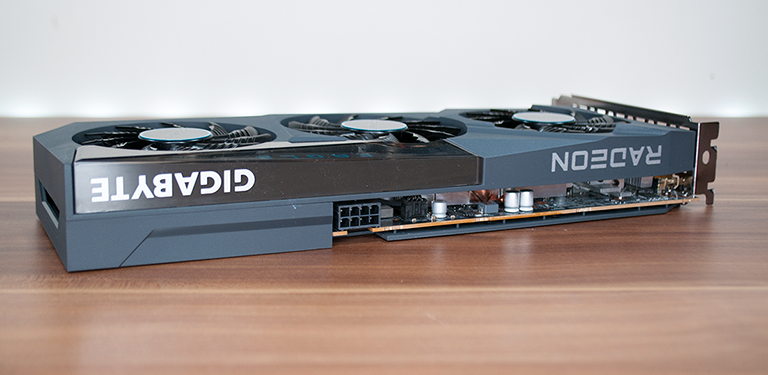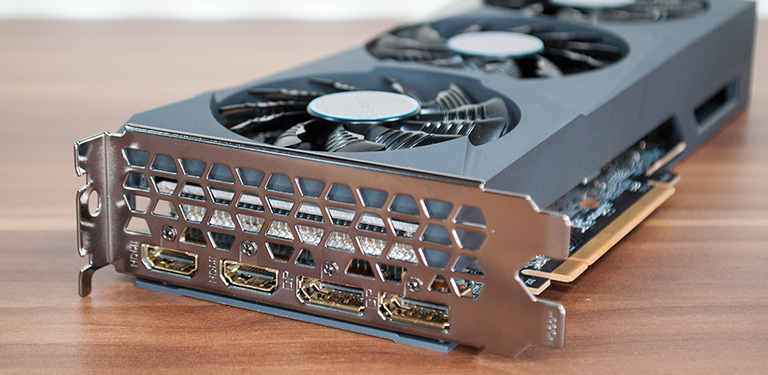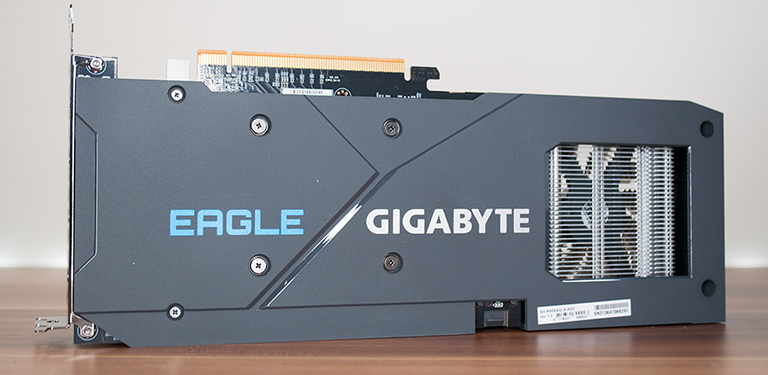Introduction
PC gamers are understandably struggling to feel enthusiastic about upcoming hardware. Unprecedented global events have resulted in a perfect storm of huge demand, short supply and inflated pricing, putting new graphics cards beyond the reach of the average consumer. A shame, really, as the current crop of AMD and Nvidia GPUs have plenty of merit, and a fair few would be easily recommended were they readily available at anywhere near the MSRP.
The show must go on and having introduced a smaller RDNA 2 GPU back in August - Radeon RX 6600 XT - AMD was always likely to flesh out its range with further models cleaved from the efficient 237mm² Navi 23 die. Enter Radeon RX 6600, arriving today priced at $329 / £300.
Radeon RX 6900 XT |
Radeon RX 6800 XT |
Radeon RX 6800 |
Radeon RX 6700 XT |
Radeon RX 6600 XT |
Radeon RX 6600 |
Radeon RX 5700 XT |
|
|---|---|---|---|---|---|---|---|
| Launch date | December 2020 |
November 2020 |
November 2020 |
March 2021 |
August 2021 |
October 2021 |
July 2019 |
| Codename | Navi 21 |
Navi 21 |
Navi 21 |
Navi 22 |
Navi 23 |
Navi 23 |
Navi 10 |
| Architecture | RDNA 2 |
RDNA 2 |
RDNA 2 |
RDNA 2 |
RDNA 2 |
RDNA 2 |
RDNA |
| Process (nm) | 7 |
7 |
7 |
7 |
7 |
7 |
7 |
| Transistors (bn) | 26.8 |
26.8 |
26.8 |
17.2 |
11.1 |
11.1 |
10.3 |
| Die Size (mm²) | 519 |
519 |
519 |
336 |
237 |
237 |
251 |
| Full Implementation of Die | Yes |
No |
No |
Yes |
Yes |
No |
Yes |
| Hardware Raytracing | Yes |
Yes |
Yes |
Yes |
Yes |
Yes |
No |
| Infinity Cache (MB) | 128 |
128 |
128 |
96 |
32 |
32 |
No |
| Compute Units | 80 |
72 |
60 |
40 |
32 |
28 |
40 |
| Processors | 5,120 |
4,608 |
3,840 |
2,560 |
2,048 |
1,792 |
2,560 |
| Texture Units | 320 |
288 |
240 |
160 |
128 |
112 |
160 |
| ROP Units | 128 |
128 |
96 |
64 |
64 |
64 |
64 |
| Boost Clock (MHz) | 2,250 |
2,250 |
2,105 |
2,581 |
2,589 |
2,491 |
1,905 |
| Game Clock (MHz) | 2,015 |
2,015 |
1,815 |
2,424 |
2,359 |
2,044 |
1,755 |
| Peak GFLOPS (SP) | 23,040 |
20,736 |
16,166 |
13,215 |
10,605 |
8,928 |
9,750 |
| Memory Type | GDDR6 |
GDDR6 |
GDDR6 |
GDDR6 |
GDDR6 |
GDDR6 |
GDDR6 |
| Memory Size (GB) | 16 |
16 |
16 |
12 |
8 |
8 |
8 |
| Memory Clock (MHz) | 16,000 |
16,000 |
16,000 |
16,000 |
16,000 |
14,000 |
14,000 |
| Memory Bus (bits) | 256 |
256 |
256 |
192 |
128 |
128 |
256 |
| Max Bandwidth (GB/s) | 512 |
512 |
512 |
384 |
256 |
224 |
448 |
| PCIe Support | Gen 4 x16 |
Gen 4 x16 |
Gen 4 x16 |
Gen 4 x16 |
Gen 4 x8 |
Gen 4 x8 |
Gen 4 x16 |
| Power Connectors | 8+8 |
8+8 |
8+8 |
6+8 |
8 |
8 |
6+8 |
| TBP (watts) | 300 |
300 |
250 |
230 |
160 |
132 |
225 |
| GFLOPS per watt | 76.8 |
69.1 |
64.66 |
57.46 |
66.28 |
67.63 |
43.3 |
| Launch MSRP | $999 |
$649 |
$579 |
$479 |
$379 |
$329 |
$399 |
Manipulating a particular die to hit a variety of price points is a familiar tactic and AMD reduces the Navi 23 entry fee by 13 per cent through a series of hardware cuts. Compared to the full die, as featured in the original XT, the lesser RX 6600 loses four full compute units, contracting processor and texture unit count to 1,792 and 112, respectively. No coincidence that that happens to be a 13 per cent reduction.
The amount of Infinity Cache remains unchanged, as do the 64 ROPs and 128-bit memory bus, but the brakes have been applied to the 8GB GDDR6 frame buffer, which sees speed reduced by, you guessed it, 13 per cent, from 16Gbps to 14Gbps. The resulting, more frugal GPU still requires an eight-pin power connector, but with a 132W TBP is designed as an energy-efficient 1080p solution with full support for hardware raytracing. A key selling point, but with one raytracing accelerator per CU, Radeon GPUs at this end of the scale lack the muscle to deliver meaningful raytracing smarts.
With no MBA (Made By AMD) board to support the launch, it is over to partners to deliver the goods. All the big names will be presenting RX 6600 cards on day one, and Gigabyte's Eagle 8G is first on the review table. As expected, there's no real need to start afresh on a more mainstream 1080p GPU, and Gigabyte is more than happy to carry across the triple-fan WindForce cooler that exists on a wide range of existing models.
Board dimensions are identical to the 6600 XT variant at 282mm x 113mm x 41mm and a total weight of just 660g is indicative of the entry-level positioning. We might see even smaller RX 6600 cards - the 132W TBP bodes well for a mini-ITX format - yet in a regular chassis the Gigabyte build ticks the relevant boxes. There's not going to be any unwanted sag, the dual-slot form factor will fit in practically every chassis, and cooling performance is more than adequate.
Restrained is the way to go and it has been a while since we last examined a graphics card with so little going on. That's no bad thing, mind. An absence of RGB lighting suits us just fine, we appreciate having just a single eight-pin power connector, and is there any real need for a factory overclock or dual BIOS on an RX 6600? Probably not.
Focussing on matters of more importance, we like the fact that Gigabyte has retained a backplate for greater rigidity and tidier aesthetics, and the three 80mm fans are in keeping with higher-end models. Adjacent fans spin in the opposite direction to reduce turbulence, all three turn off completely when temperature is below 55°C, and if there's a criticism it's that the trio switches into a higher gear sooner than necessary. Our logs reveal an audible fan speed of 1,800RPM while gaming, and we'd be inclined to manually lower that curve for a near-silent experience.
There are no major surprises in the output department, where Gigabyte hedges its bets with two HDMI 2.1 alongside two DisplayPort 1.4. Overall build quality is solid - even the plastic top shroud feels sturdy - and the cooler is clearly overkill for the baby of the RDNA 2 bunch. Look closely and you'll notice the PCB measures a little over 180mm, meaning the full-length aluminium heatsink overhangs the board by some margin.
The big question mark, and it's a sore one for PC gamers who are already feeling the pinch, is whether or not RX 6600 delivers a level of performance to match the purported £300 price tag. Well, expectations are going to have to be kept firmly in check. Architectural cuts suggest that performance will be down up to 15 per cent compared to RX 6600 XT, and Nvidia's rival GeForce RTX 3060 poses serious threat at the same alleged price point. The emphasis is on alleged as the only 6600 XT and RTX 3060 cards in stock at the time of writing start at a lofty £500.
AMD naturally views the RX 6600 as an upgrade path from older GPUs - performance is said to be up by 23 per cent over a GeForce RTX 2060 - but we've seen a significant shift in pricing in the space of a few generations and have landed at a stage where basic 1080p cards are fetching well in excess of £300.
There's no immediate answer, and supply constraints are expected to continue well into 2022, but for now, let's crack on to the benchmarks and see exactly how the latest Radeon fares at both 1080p and 1440p resolutions.













